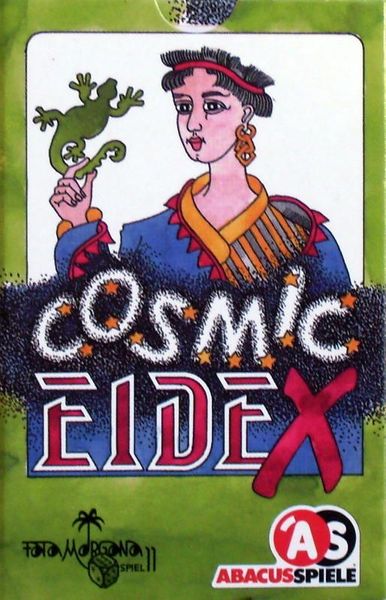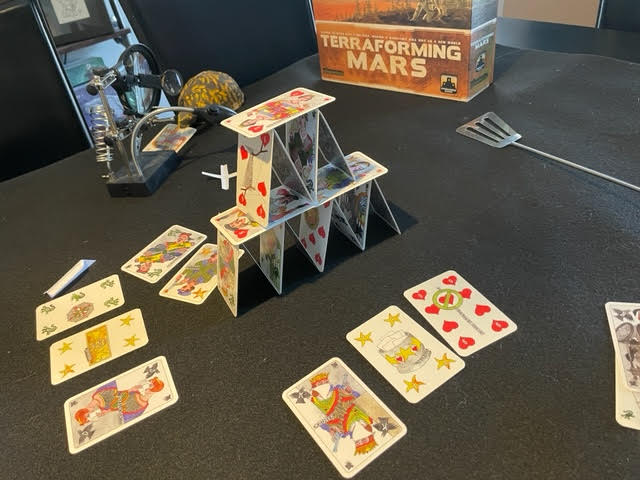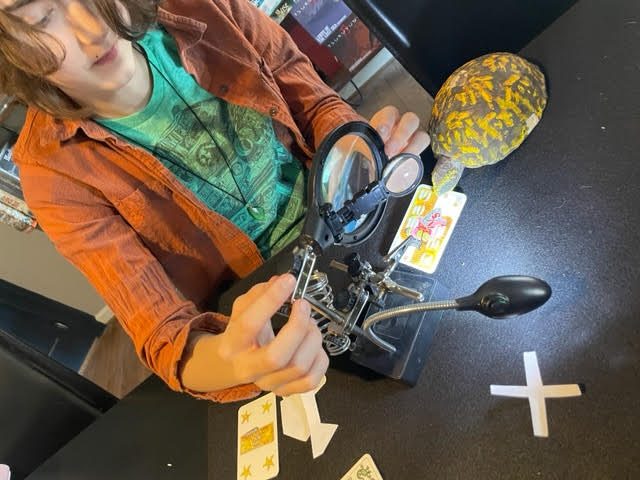Like so many long-term gamers, I have dozens of unopened game boxes lingering on my Shelf of Shame. Whether I lack the table space, the time, or the proper audience, I’m constantly lacking something. Some games don’t get played because the games didn’t supply rulebooks. I may not be able to do anything about tables or people, but after decades of playing board games, I’m confident I can make sense of any game from the components alone.

Game 1: Cosmic Eidex:
In Cosmic Eidex, 2-4 enterprises strive to colonize the Red Planet. To do so, they must complete three objectives: (1) collectively oxidize the atmosphere by stocking arboretums; (2) establish the greatest of lakes; (3) properly set the thermostat so the CEOs of the organizations can argue with their wives about how expensive it is to heat an entire planet. These goals are accomplished through a series of events initiated through card play, then funded by carefully calculated resources management.
You might think such a game would require multiple decks of cards, individual player boards, a game board with the planet dissected into 61 available hexes, three metallic flavors of cubes, a half dozen colorful cubes that don’t taste at all like the corresponding-colored fruit, and sufficient cardboard to make WALL-E weep in resignation.

Cosmic Eidex accomplishes this with one deck of 36 cards. Every card is multi-purpose, but the iconography of the trumps is easy to comprehend, so long as you use the pneumonic device E-I-D-E-X.
E – Echocardiograms (Hearts)
I – Iguanas (Lizards)
D – Dark Doves of Death (Blackbirds)
E – Echinodermata (Starfish)

The X doesn’t matter. It wasn’t part of the original name, as anyone can plainly see by the inconsistent font on the box. Still, the game’s designers didn’t want to confuse anyone with yet another game about Cosmic Enhanced Integrated Drive Electronics. The X, meaningless or not, gives the game intergalactic street cred.
Additionally, each card bears a title and individual illustration, the same as it’s Terraforminating Marzipan counterpart. Some examples:
The 6 of Dark Doves of Death displays a scene at the mall, where a red bird, orange bird, heart and starfish were swallowed up in the mob of Black Friday. Playing that card face-up opens the market, where all players participate in a blind auction—the winner visits the nearest gas station at 2:00 a.m. in order to get the best prices on rocket fuel. The losers have to carry said fuel to the launching pad. Space transport is expensive!

The 10 of Echocardiograms doubles as a Target card, with deep discounts on products you’ll love! Said card can be ripped into six pieces, each bearing a value of their corresponding 10. First player to purchase plant seeds demonstrates their concern for the environment, thereby earning the title Fursorge. The title moves to other players when the current Fursorge no longer cares.
The 7 of Echinodermata is the Jackpot card. Alas, this deck has no jacks on their face cards, instead employing Kelvins, Donnas, and Brads. I was disappointed in the lack of diversity, but the design fits the theme: sending such a limited number of people to colonize a planet is bound to propagate inbreeding.
Most importantly, each suit has its own version of an Ace. The Ace of Iguanas becomes the Dealer and assumes dual roles. One: that player must shuffle and distribute the cards for the next hand. Two: that player must stash all of his iguanas in dime bags and become the distributor to feed the addictions of the cosmonauts. Indeed, the card backs show an illustration of the Iguanidionysis constellation, representing the galactic God of intoxicated reptiles and amphibians.
Each turn, players select one card to play. They hold the card at arm’s length overhead, and release it with hopes of landing it directly on the X. If their card does not land directly on the X, it is considered to have bounced off the shallow atmosphere and lost in space forever. Those cards should be placed back in the box, shipped to NASA, and jettisoned into the universe during the next launch so they can say hello to Mr. Spock.

Each suit represented earns an amount of resources (E, I, D, E, remember?) corresponding to the number on the card. Track those resources mentally, as well as the amount of space lumber you’ll need to build arboretums on our world-next-door.
Enact the cards powers of face cards alphabetically. For example, Echinodermata Brad the Scharf Macher would sharpen his pickle, and doing so would cause Donna the Dark Dove of Death Schuchterne to shield her eyes, which would cause Kelvin the Echocardiogram Voyeur to adjusted his binoculars. Synergy of this caliber has been missing from other space games, no matter how many giant ice asteroids and space elevators they may contain.
Continue teaching millennials which direction clockwise is on their digital readouts, and pass your unused cards to the player to your left so they can incorporate your lizards into their master strategies. The first player to successfully translate enough German to travel to the Scarlet Marble wins!

Each experience with Cosmic Eidex was a unique exercise in futility. Thus far, the furthest any of us has progressed toward terraforming Mars is selecting the larger box and better game from the shelf.
While themes and some illustrations may not be suitable for young gamers, Cosmic Eidex can double as a technique to learn counting, specifically the numbers between 6-10. This can be especially useful for players who have only one hand.
5-240 Players
Mechanics: Cards, memory, mathematics, trick-giving, economic, product placement, bluffing, speed-storytelling, etiquette
Play time: 5-240 minutes per player
Ages: Yes it does, but not well
Special thanks and apologies to Jeff Kornberg for The Dragon’s Tomb, who inspired me to expand my horizons and learn new things.











Add Comment